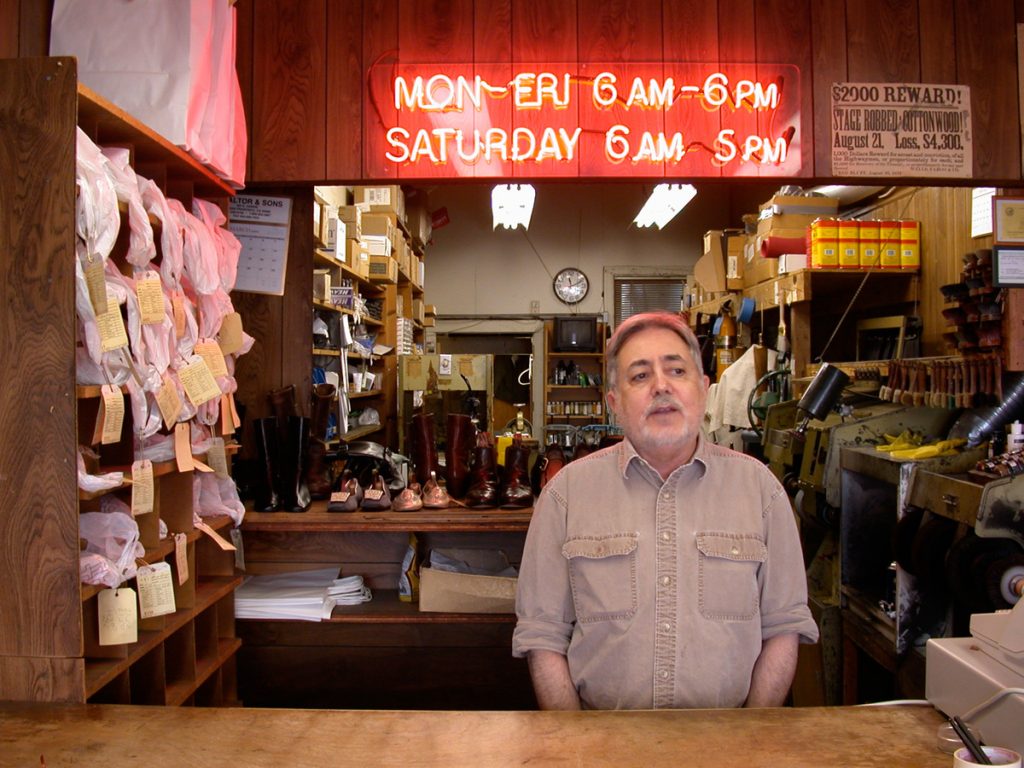
Longtime Fillmore cobbler Ed Nahigian, owner of SF Boot and Shoe Repair.
LOCALS | JAMES CARBERRY
“I was standing right here when it hit,”says Ed Nahigian, the veteran owner of San Francisco Boot & Shoe Repair, occupying his usual position behind the front counter where he greets customers.
It’s the same place he was standing shortly after 5 p.m. on Tuesday, October 17, 1989, talking to a customer who had dropped by the shop at 2448 Fillmore Street to pick up his loafers.
A chandelier in the store window suddenly started to vibrate. He knew in a nanosecond what was happening.
“I think we’re having an earthquake,” he told his customer.
Nahigian turned to alert his 12-year-old son and an employee in the back of the shop. A wall was undulating as if invisible waves were coursing through it. Fearful that the building might collapse, he shouted for everyone to get out of the store.
Seconds after they were outside, the earthquake ended as suddenly as it had started. The building was still standing, and the store had not been damaged. Other buildings on Fillmore Street also seemed to be intact.
A woman who had parked in front of the shop turned up her radio, and people gathered around to listen to the news. There was a report of fires in the Marina.
Nahigian hurried up Fillmore to Broadway to look down on the Marina. Sure enough, fires had broken out and some apartment buildings and a number of homes were severely damaged. Nahigian ran back down Fillmore to report what he had seen. By the time he got back to the shop, he was exhausted and feeling a little nauseous. It began to sink in that he had just lived through an earthquake.
As night came on, news reports made clear there had been extensive earthquake damage in the Bay Area. Part of the Bay Bridge had collapsed, as had part of the Nimitz Freeway in the Oakland. Earthquake damage had forced the closure of the Embarcadero Freeway, which would later be torn down. The earthquake struck just as third game of the World Series was about to begin, and the San Francisco Giants and Oakland Athletics would wait to play another day. Because the Series was broadcast globally, people all over the world saw the earthquake live on television.
As he had done many times before, Nahigian locked up his store and went home for the night. On Wednesday morning he returned to the shop, although there was no business to be done. The power was out, and the phones were dead.

As the day progressed, the neighborhood filled with people. “Everybody wanted to be outside with other people,” Nahigian says. “We were all hugging one another — we realized how fortunate we were.”
Early Thursday morning the power came on, and phone service later was restored. Gradually life began to return to normal on Fillmore Street and elsewhere. But it would be a long time before the Bay Area fully recovered from the Loma Prieta earthquake, which originated in Santa Cruz County, lasted about 15 seconds and measured 6.9 on the Richter scale.
Despite the memories of the 1989 earthquake and the constant threat of another one, Ed Nahigian remains glad he set up shop in the neighborhood.
Born and raised in the Central Valley, he learned the shoe repair business from his parents. He had always dreamed of living in San Francisco, so when his parents moved to Marin County, he started scouting out neighborhoods in San Francisco where he night open a business.
One day he was driving through the Marina and came to the foot of Fillmore Street.
“I turned right at a Colonel Sanders and drove up Fillmore, wondering whether my VW would make it up the hill,” he says. He found a shoe store on Fillmore Street, took over from a previous tenant, renovated the shop and opened for business. That was in 1980, and his store is now one of the oldest on Fillmore Street.
Nahigian has seen many changes in the neighborhood, where he both lives and works. “There used to be a lot of professional people in their 40s or older — they would pack the downtown buses every weekday morning,” he says. “While there are still a lot of professionals here, they are younger, and there are more families with young children living in the neighborhood.”
Nahigian says he has stayed in business for so long by providing superior customer service.
“I use the best materials, and I decline to do certain types of work, like leather bags” he says. His business has changed over time. “My work used to be equally divided between men’s and women’s shoes,” he said. “Now it’s almost 90 percent women’s work.”
He says he has learned to accept life’s inevitable changes. “You don’t know what tomorrow will bring,” Nahigian says, “but you can appreciate and enjoy what you have.”
Early most mornings, Nahigian walks from home to his store, which is open every day except Sunday. He lives near St. Dominic’s Church, whose tower was severely damaged in the 1989 earthquake, and later repaired, shortened and strengthened.
Filed under: Locals, Neighborhood History





